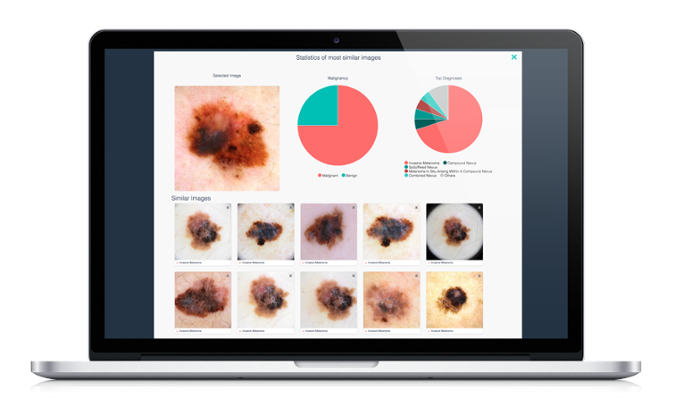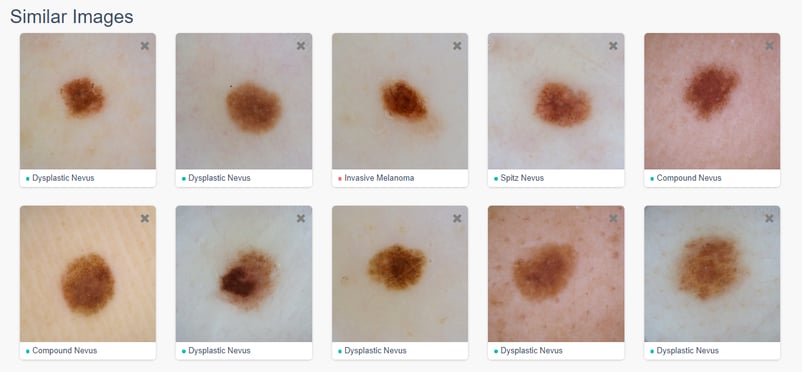Visual Search: A Powerful, Intelligent Tool in Dermatology
“You can have data without information, but you cannot have information without data.” – Daniel Keys Moran
How can artificial intelligence (AI) change the way you find dermoscopic images?
When you want to search for an image, you typically choose a few keywords that describe it and then submit them into a search engine. The problem with this is that many images are simply too complex to describe. For example, to accurately describe a specific mole you would have to provide a detailed description in order to correctly capture the shape, size, texture and colour. Additionally, all the images you were searching over would require detailed descriptions as well, which would require a significant amount of time and effort to label.
Rather than trying to come up with keywords, it is much easier to use Content Based Image Retrieval (CBIR).1 This technique no longer requires textual information, but instead the visual attributes present within an image are used to retrieve similar images.
We created an intelligent dermatology software known as Visual Search to provide an easy solution for medical professionals to find similar cases. A key underlying component that powers Visual Search is the use of a convolutional neural network (CNN).2 CNNs take an image and convert it into a compact vector representation (a series of numbers that the computer can easily process) whilst retaining the visual information found in the original image. These feature vectors are used to quickly and efficiently retrieve images that are visually similar.

In this image of results returned from the dermatology software, we can see that the returned moles all look similar to one another. They are mostly round dark moles, and the system has learned that the skin color is not an important factor when deciding which images to retrieve. This provides medical professionals a valuable tool for examining patient cases.

Applications and Benefits
Now that we’ve identified how content-based image retrieval (CBIR) works, it’s time to discuss how it can be utilized. It is clear that CBIR allows for the fast identification of similar images and provides a comprehensive and effective way to locate pictures. The question becomes "How can this tool be used?" The answer is, everywhere. 3
For example, DermEngine’s use of CBIR in Visual Search drastically transforms the way medical professionals can perform consultations. Traditionally, the patient would have to visit their doctor, get their mole checked, have images sent to a dermatologist for confirmation, then receive a diagnosis. Getting an appointment with a dermatologist can alone take over a month.4
Instead of using all these resources to find an answer, Visual Search provides professionals with an efficient, fast and intelligent solution. An expert can take a picture of a patient’s mole and use DermEngine's intelligent algorithms to instantly find similar moles that have already been diagnosed.
Additionally, medical professionals can use intelligent clinical decision support tools like these as an educational resource. Experts can utilize the database of pathology-labelled images obtained from dermatologists around the world to help train or teach medical students, researchers or non-expert physicians.
ConclusionStudies show that artificial intelligence (AI) is a drastically growing market in the field of healthcare. It is clear that content-based image retrieval (CBIR) has a wide variety of applications within this field: it allows you to quickly find images, is an educational resource, increases efficiency, and is always improving. This technique has excellent applications in the healthcare industry where it could have an unprecedented impact on the early detection of cancerous lesions. Although research is continuous, it is clear that CBIR will revolutionize the way healthcare professionals treat their patients.
-The MetaOptima Team
Would you like to learn more about what Visual Search can do and how it can support your practice? Click below.
Sources:- http://bigdata-madesimple.com/30-thought-provoking-big-data-quotes-that-you-should-know/
- https://link.springer.com/chapter/10.1007/978-3-642-23169-8_3
- https://adeshpande3.github.io/adeshpande3.github.io/A-Beginner%27s-Guide-To-Understanding-Convolutional-Neural-Networks/
- https://www.ncbi.nlm.nih.gov/pmc/articles/PMC2675494/
Topics: Visual Search CBIR Artificial Intelligence





